Muskie Quest
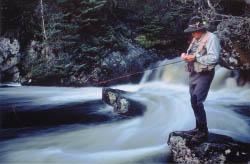
By Chris Marshall
Glen Hales photos
Conversations with a muskie addict
I suspect that a number of fly fishers in Ontario and Quebec have taken at
least one muskie on a fly. However, I also suspect that most were incidental
catches. I must admit to being one of them–all my fly rod muskie have been
taken when I've been fishing for bass. Not that I haven't tried, but, although
I've had follows–hits, even–I've never managed to hook one when I've
specifically targeted them.
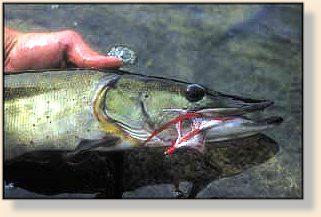 Nevertheless, a few fly fishers target muskie with the fly rod and take them
with some consistency. One of these is Glen Hales, our associate photo editor,
my occasional fishing companion, and a much better fly fisher than I am (maybe
because he seems to be able to get out fishing much more frequently). The
following information is based largely on his experience.
Nevertheless, a few fly fishers target muskie with the fly rod and take them
with some consistency. One of these is Glen Hales, our associate photo editor,
my occasional fishing companion, and a much better fly fisher than I am (maybe
because he seems to be able to get out fishing much more frequently). The
following information is based largely on his experience.
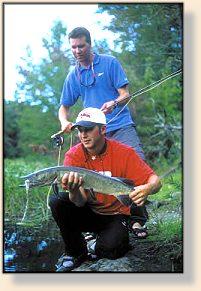
Eastern Ontario, where we live, has only a few streams worth fly fishing for
trout, especially in the dog days of summer. However, we have plenty of excellent
warm water fly fishing to compensate. This includes some of Ontario's muskie hot
spots on Moira Lake at Madoc, on Stoco Lake at Tweed, and in the Moira River
which flows through both. Stoco Lake, the prime hotspot, yields at least a couple
of forty pounders every year. There are also a number of lesser-known rivers and
lakes, which also have good muskie populations.
Big muskie are elusive beasts, especially in big waters where they're usually spread
so thinly that it's necessary to cover lots of water in order to locate them. On Stoco
and Moira Lakes, the hardware boys overcome this by trolling. We could emulate
them by trolling with a fly rod, but we prefer to cast. For this reason, we do most
of our fishing for muskie in smaller waters.
There is one small river which is perfect. It has very few pike and a good concentration
of muskie. Most of them are less than 10 pounds, but there are a few much bigger fish
to keep us honest. For almost its whole length, the river flows through uncultivated
land and access points are few, with the result that it's only lightly fished. We fish it
from a light punt equipped with an electric motor, but a canoe would be even better.
The shores are lined with grasses, cattails and weedbeds. Many of these are close to
deeper water–ideal muskie habitat.
When & Where
Muskie are most easy to tempt with a fly at the very beginning of the season (the
beginning of June in our part of Ontario). At this time, hungry after the rigours of
spawning, they're feeding voraciously. They also tend to hold in shallow water
where they're highly visible. As the season progresses, their appetite tends to
moderate and they move to deeper water and cover. June also offers the best
chance of big fish in big waters.
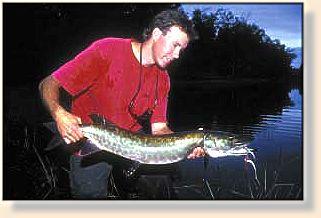 However, by fall they're fat, sleek, and packed with energy. If action is what
you're after, this is the by far the best time to target them, but be prepared to
put in considerably more hours of searching and casting before you get a hit.
However, by fall they're fat, sleek, and packed with energy. If action is what
you're after, this is the by far the best time to target them, but be prepared to
put in considerably more hours of searching and casting before you get a hit.
On Stoco Lake, for a couple of weeks in June, some huge fish hang around in
the lower reaches of the Moira River where it enters the lake. In pools no more
than three feet deep, they're easily spotted, sitting like steelhead in the slacker
water at the edges of the flow. Glen stalks them in the Crawdad, but the time is
brief before they drop back into the lake for the rest of the season.
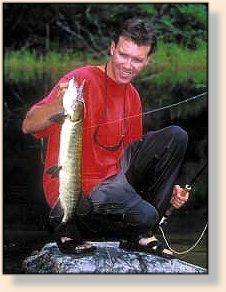
After this, the most productive fishing is on smaller waters where the fish are
more concentrated and easy to find. They tend to be smaller, but offer much
more action than the widely dispersed fish in the bigger lakes. However, if you're
set on getting the big one and are willing to accept many fishless days, by all means
target the big lakes. For this, knowing where muskie are most frequently caught
makes the task much less formidable. Concentrate on these places and stick with
it until you hit paydirt. If you're not familiar with the lake, watch the locals. You
might be lucky enough to get useful information by asking around, but don't count
on it, as muskie addicts are notoriously tight-lipped.
Presentation
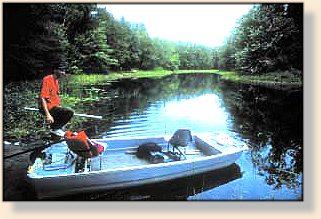 After the first couple of weeks of the season, muskies in most waters lurk around
ambush points. On the small rivers we fish, these are frequently tight against the
shore and often in surprisingly shallow water. Look for them along the edges or
in the middle of patches of wild rice and aquatic grasses. Eddies are good places,
especially those with emergent vegetation along the edges. On the lakes, ambush
points are usually close weed beds and emergent vegetation adjacent to deeper
water. In all cases, cast beyond the ambush point and retrieve the fly back through
it or in the open water just beyond it.
After the first couple of weeks of the season, muskies in most waters lurk around
ambush points. On the small rivers we fish, these are frequently tight against the
shore and often in surprisingly shallow water. Look for them along the edges or
in the middle of patches of wild rice and aquatic grasses. Eddies are good places,
especially those with emergent vegetation along the edges. On the lakes, ambush
points are usually close weed beds and emergent vegetation adjacent to deeper
water. In all cases, cast beyond the ambush point and retrieve the fly back through
it or in the open water just beyond it.
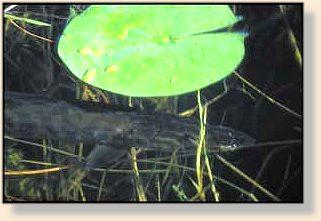
Your fly should make as much noise and commotion as possible. This is easy with
hardware, but less so with a fly – we're still trying to invent a fly which makes as much
noise as a spinnerbait or jerk bait. A fast retrieve is usually best, provoking explosive
strikes. For the fastest possible retrieve, try a saltwater double-handed strip with the
rod tucked under your arm. Make that fly rip through the weeds. This why weed
guards are essential.
You'll usually get more follows than hits. If you see a muskie following, don't slow
down – speed up. If you slow down, it will invariably turn away, but the sudden
increase in speed sometimes provokes a strike.
Equipment
 You need a relatively heavy outfit, even when you're targeting mainly smaller fish,
in order to cast the huge, wind-resistant flies. On smaller rivers and lakes you can
get away with an 8 weight outfit, provided the rod has plenty of backbone, but if
you're after the big fellows out in the big water, you need at least a 10 weight. Most
of the fishing is on or just beneath the surface, so a floating weight forward line is what's
needed. Some manufacturers make special pike/muskie tapers. It pays to have at least
100 yards of backing, especially on open water.
You need a relatively heavy outfit, even when you're targeting mainly smaller fish,
in order to cast the huge, wind-resistant flies. On smaller rivers and lakes you can
get away with an 8 weight outfit, provided the rod has plenty of backbone, but if
you're after the big fellows out in the big water, you need at least a 10 weight. Most
of the fishing is on or just beneath the surface, so a floating weight forward line is what's
needed. Some manufacturers make special pike/muskie tapers. It pays to have at least
100 yards of backing, especially on open water.
Muskie aren't exactly leader-shy, so leaders can be as short as three or four feet. The
main problem is preventing bite-offs. Glen gets around this by using a single length of 30
pound test Spiderwire, a braided line used by hardware fishers. It doesn't stretch, it's
much more flexible than heavy mono, it's impervious to teeth, and (unlike steel) it
doesn't become weakened through kinking. ~ Chris Marshall
Next time - The Flies!
|



 After the first couple of weeks of the season, muskies in most waters lurk around
ambush points. On the small rivers we fish, these are frequently tight against the
shore and often in surprisingly shallow water. Look for them along the edges or
in the middle of patches of wild rice and aquatic grasses. Eddies are good places,
especially those with emergent vegetation along the edges. On the lakes, ambush
points are usually close weed beds and emergent vegetation adjacent to deeper
water. In all cases, cast beyond the ambush point and retrieve the fly back through
it or in the open water just beyond it.
After the first couple of weeks of the season, muskies in most waters lurk around
ambush points. On the small rivers we fish, these are frequently tight against the
shore and often in surprisingly shallow water. Look for them along the edges or
in the middle of patches of wild rice and aquatic grasses. Eddies are good places,
especially those with emergent vegetation along the edges. On the lakes, ambush
points are usually close weed beds and emergent vegetation adjacent to deeper
water. In all cases, cast beyond the ambush point and retrieve the fly back through
it or in the open water just beyond it.
 Nevertheless, a few fly fishers target muskie with the fly rod and take them
with some consistency. One of these is Glen Hales, our associate photo editor,
my occasional fishing companion, and a much better fly fisher than I am (maybe
because he seems to be able to get out fishing much more frequently). The
following information is based largely on his experience.
Nevertheless, a few fly fishers target muskie with the fly rod and take them
with some consistency. One of these is Glen Hales, our associate photo editor,
my occasional fishing companion, and a much better fly fisher than I am (maybe
because he seems to be able to get out fishing much more frequently). The
following information is based largely on his experience.
 However, by fall they're fat, sleek, and packed with energy. If action is what
you're after, this is the by far the best time to target them, but be prepared to
put in considerably more hours of searching and casting before you get a hit.
However, by fall they're fat, sleek, and packed with energy. If action is what
you're after, this is the by far the best time to target them, but be prepared to
put in considerably more hours of searching and casting before you get a hit.
